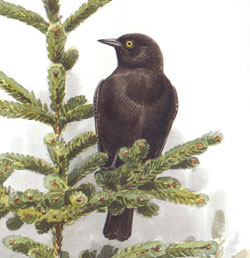Breeding Bird Atlases (BBA)
Find a Bird - BBA1
Breeding Bird Atlas 1 Species Accounts
Rusty Blackbird
Euphagus carolinus
Egg Dates
19-May
Number of Broods
one

The Rusty Blackbird is the least frequently observed of the blackbirds that occur regularly in Massachusetts, although it is an occasional summer resident and a moderately common transient. It is known mainly as a migrant in the early spring and again in the fall, when its numbers are probably somewhat greater than its visibility would indicate. Unlike other blackbirds, Rusty Blackbirds are found infrequently in fields and pastures but instead prefer to feed quietly in wooded swamps and along borders of woodland ponds. Flocks seldom number more than 75 to 100 individuals.
The Rusty Blackbird is entirely an inhabitant of the Canadian Zone in the breeding season, nesting as far north as treeline in Ungava and Alaska and south to northern New England, wherever there are bogs, swamps, and small ponds where spruce, fir, willows, and alders are growing along the margins.
For years this blackbird has been an occasional summer resident about wetlands among the higher hills of Vermont and New Hampshire, south nearly to Massachusetts. Until recently, however, it has never been “confirmed” breeding in this state. One of the gratifying results of the Breeding Bird Atlas was the discovery of 2 nests in 1977 in the higher hills of Berkshire County. One was in a spruce sapling in a swamp near a small pond in the Savoy Mountain State Forest. The other was also in a young spruce located at the edge of an active Beaver pond in the town of Florida. Several other observations of Rusty Blackbirds were made in the breeding season in the same general area, and breeding was subsequently “confirmed” in Franklin County.
The first spring migrants appear in early March, and migration continues through April into the first few days of May. The species is fairly common in spring in central and western parts of the state but is decidedly uncommon in southeastern sections of Massachusetts. Its presence in this season is often most evident from its song, tolalee-eek, which resembles a squeaky hinge and can alert the observer to the presence of a flock in a flooded maple swamp or other impenetrable habitat. The call note is a chuck slightly softer than that of the Red-winged Blackbird.
The nest is usually located in a spruce and is a bulky construction of twigs with the inner cup lined with fine twigs and grasses. Heights range from 2 to 20 feet. Unlike some other blackbirds, this species does not nest in colonies. The four to five eggs are incubated solely by the female for a period of about 14 days. During the incubation period, the male feeds the female, but when the eggs hatch both parents tend the young. The immatures fledge in about two weeks and remain in loose association with the adults. In Massachusetts, a partially constructed nest discovered on May 15 was deserted soon after. On May 19, a nest containing four eggs was discovered, and, at a third site, a female was observed feeding two fledglings.
The first fall migrants appear in September, and the greatest numbers are usually encountered in the middle of October, when reports are more frequent in the state’s southeastern coastal sections than in spring. Most birds seen in this season are in the rust-colored plumage, which accounts for the species’ name. Rusty Blackbirds occasionally frequent cornfields, weed patches, and gardens as well as the preferred wetland habitats, and they may at times flock with other blackbird species. Most winter in the swamps of the southern states, but a few may linger into winter in Massachusetts, especially in the milder eastern and southeastern sections. Some manage to survive the entire winter in years when the weather is not too harsh.
Map Legend and Data Summary
Atlas 1 data collected from 1975-1979


Note: rare and local in bogs at higher elevations in western Massachusetts
Richard L. Ferren



